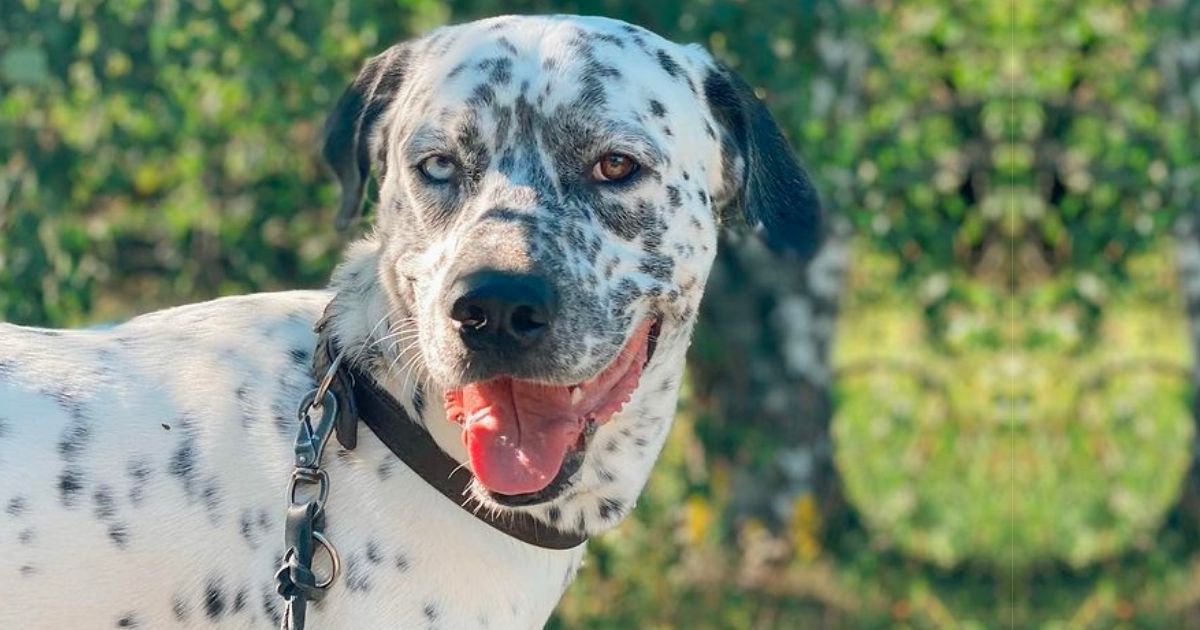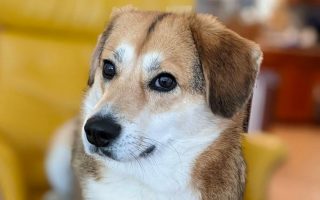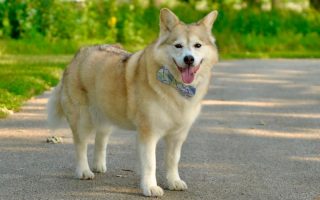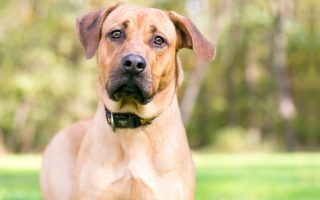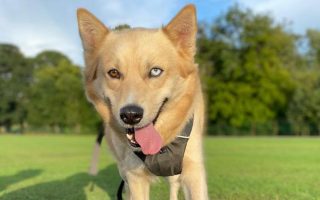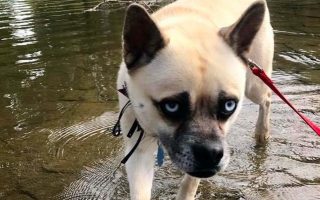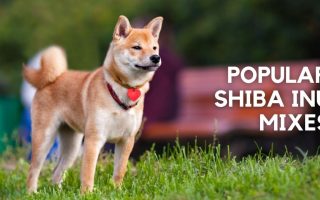The Dalmatian Husky Mix (also Dalusky) is a crossbreed between a Dalmatian and a Siberian Husky.
They tend to be medium-sized with the largest ever recorded weighing around 70 pounds.
What your hybrid looks like, its temperament, and other traits depend on which of its parent genes dominate.
Not to worry though, your Dalusky would come off as an intelligent and affable bud regardless of who it takes after.
To know better whether this hybrid matches your preferences, we urge you to review the info we’ve carefully discussed below.
Dalmatian Husky Breed Information

| Height | 16 – 24 inches |
| Weight | 35 – 70 pounds |
| Lifespan | 12 – 15 years |
| Coat | A bit dense |
| Colors | Black and white, white with black spots |
| Temperament | Active, stubborn, energetic, and loyal |
| Ideal For | Active families, experienced dog owners, homes with space |
| Puppy Price | $500 – $1000 |
Dalmatian Husky Mix Puppy – Before You Get One
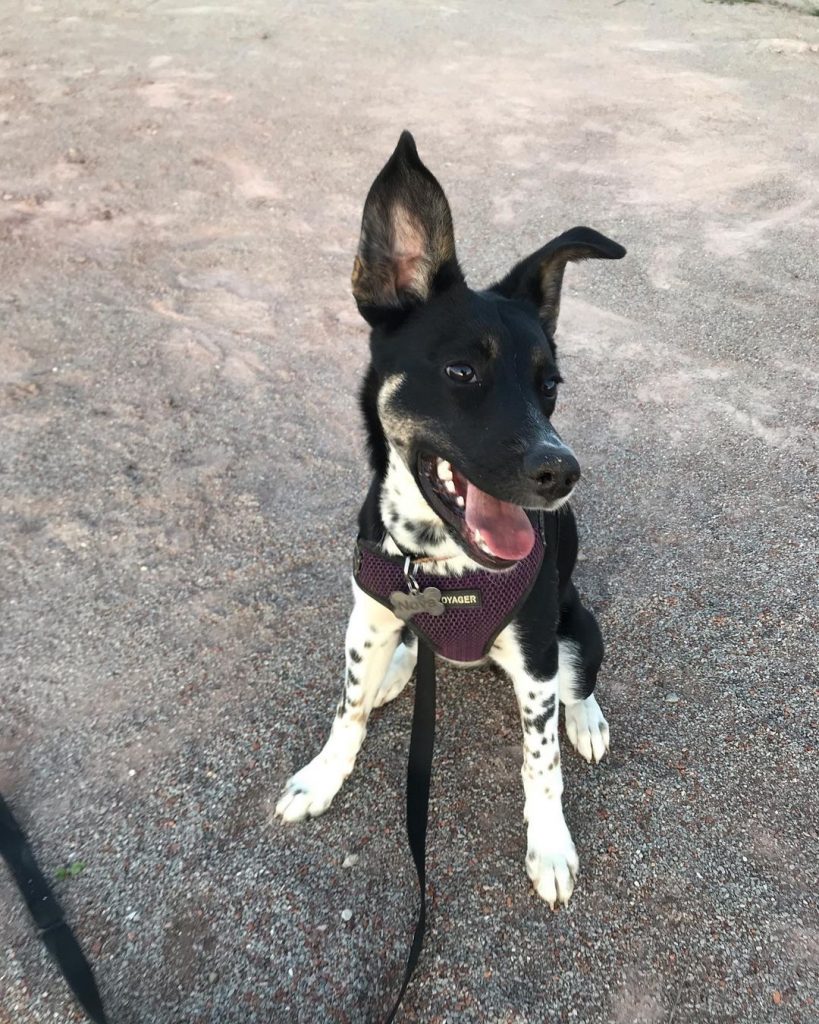
| Health | Low |
| Grooming | Medium |
| Friendliness | High |
| Energy | High |
| Trainability | Low |
The Parent Breeds
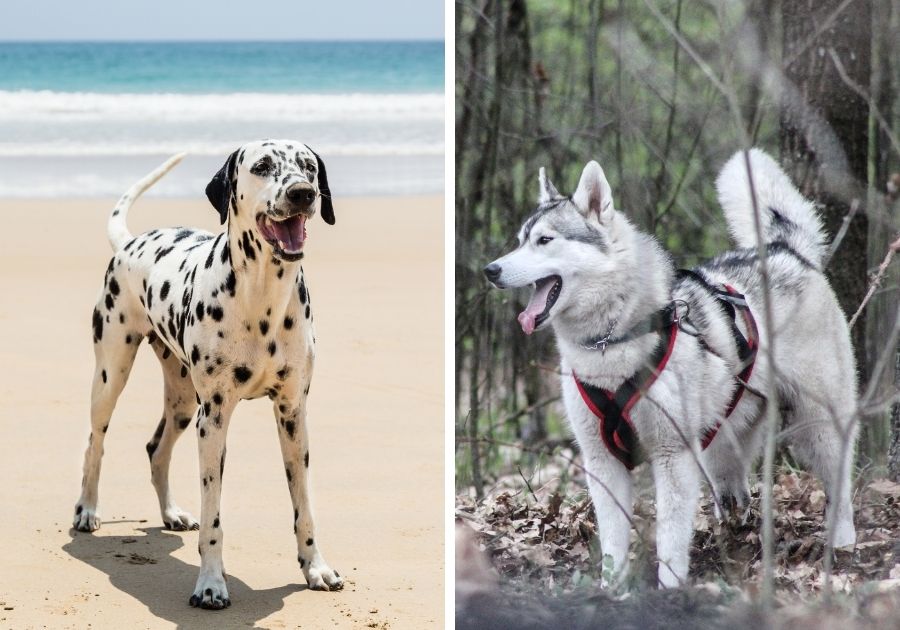
Dalmatian
The charming Dalmatian dog breed has been around for quite a while.
From serving as a coach dog to pairing alongside medieval hunters and eventually assisting in circus performances.
Perhaps, the only capacity they haven’t served in is enforcing law and order.
The only breed of dogs you would ever find on the planet with spotted coats are the Dalmatians.
On average, they weigh between 45 to 70 pounds and reach a maximum height of 19 to 24 inches.
They are known to be outgoing and stable but also hyperactive and athletic.
Other than this, they are relatively quiet, and hardly would you find them barking pointlessly.
While they tend to have a short coat, it demands periodic grooming.
They have floppy ears and as such, if your Dalusky ever takes after its Dalmatian parent, then you would need to take extra care of its ears to reduce bacteria growth.
They have a tendency to develop bladder stones as body makeup ensures the production of a high concentration of uric acid.
Beyond this, veterinarians estimate that 1 in every 5 Dalmatians would eventually grow deaf toward the end of their adult life as 1 in 8 would develop skin issues.
The American Kennel Club formally recognized Dalmatians as a breed in 1888.
Siberian Husky
Huskies generally weigh anywhere between 35 pounds to 60 pounds and on the minimum, they grow in between 10 inches to 24 inches.
Unlike you find with Dalmatians, they have a very thick double coat and you can likewise find them in six different color varieties.
Dals can manage to live alone but not so with Huskies. They feel alive most when they are part of a family as they are pack animals.
Huskies do not have to be as worried as Dals when it comes to genetics.
Regardless, they run a tendency to develop some eye complications including corneal dystrophy, progressive retinal atrophy, and cataracts.
The aforementioned conditions attack a different section of the eye.
There is a chance they may develop breathing complications later in life as they run the risk of inheriting laryngeal paralysis.
To minimize the possibilities of their inherent conditions blowing up to full scale, it is important that you allow a hip evaluation to be conducted on your husky and have an ophthalmologist evaluate your dog.
Huskies gained American Kennel Club recognition in 1930.
Huskies are social by default and early socialization for them is important.
Neglecting them all day would easily lead them to develop separation anxiety.
Fascinating Facts about the Dalmatian Husky Mix You Should Know
1. They Have Unique Coats
The coats of Dalmatians — and subsequently, Daluskies—are one-of-a-kind and no two Daluskies on the planet have the exact same spread of spots on their coats.
Just the same as you have with people, no two individuals share the same set of fingerprints.
2. This crossbreed could get along well with horses
Hardly would you get a chance to see a Dalmatian get along with horses, but believe us when we say it happens every time.
Historians believe their mutual affinity began when primordials needed hunting companions.
Dalmatians and horses had to learn to work together to become more effective at hunting and warring.
3. No spots or patches at birth
Like their parents, Daluskies do not have spots at birth. When they are born, either they are all white or they take after the monocolor of their husky parents.
That they seem monocolored does not mean they have no pigmentation spots.
The fact is they are hidden in young puppies in their early days.
For two weeks, you wouldn’t observe any extra pigmentation.
Afterward, you would notice pigmented spots on the skin, and from the third week onwards, fur that grows over the pigmented spot will grow a shade darker than the predominant fur color.
At times it can take your hybrids up to seven months before the pigmentation prevails; at times, five to six months.
4. Not many dog breeds can boast piercing blue eyes
Their Husky parent and subsequently, Daluskies, are one of the rare dogs that can boast of blue eyes without any adverse consequences.
Other dogs (for example, the Weimaraner) do have blue eyes but it results in pigmentation loss, while with Dalmatians, blue eyes have been linked to hearing defects.
5. One-third of Dalmatians are deaf or have hearing defects
Researchers estimate that about 30% of Dals have hearing impairments of all sorts, while 4%–8% are totally deaf in both ears.
An auto-recessive gene associated with the blue eyes in some Dalmatians has been linked to hearing defects.
Dalusky Appearance
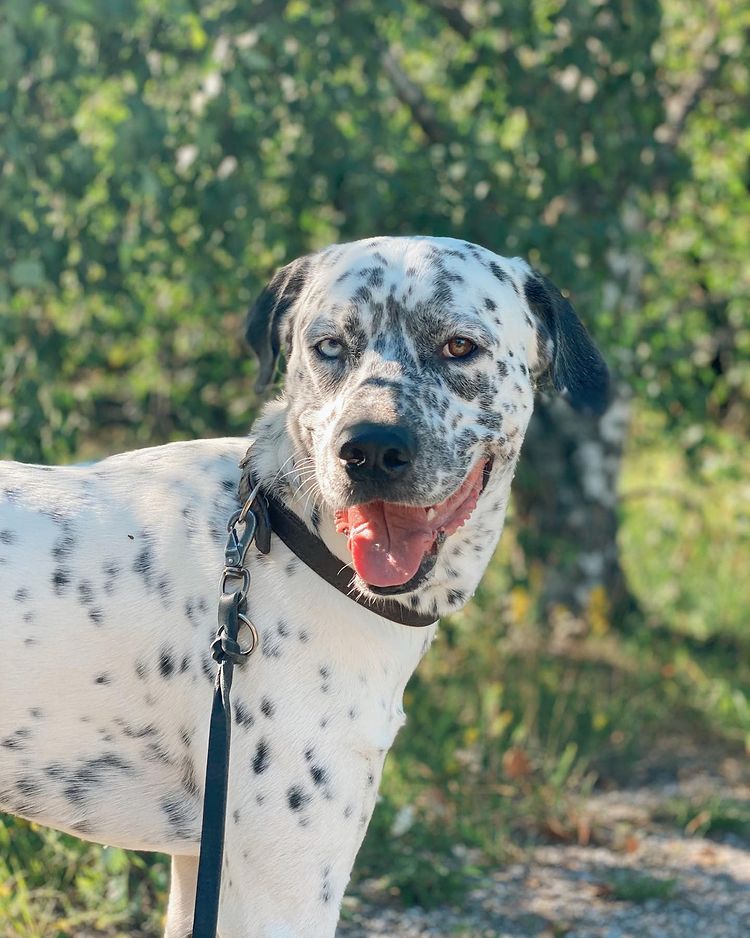
General Appearance
If your Dalusky has blue almond-shaped eyes, then you should know it is a trait they’ve inherited from their Husky parent side.
There is a chance it could be from their Dalmatian side, but the odds are low as Dalmatians tend to have averagely sized round black eyes.
A hybrid with ears as erect as a statue has inherited the trait from its Husky parent.
If their ears otherwise look folded, then their Dals’ parents’ gene has prevailed.
Dalmatians have straight tails while the Husky has a saber tail. Either tail does not have folds or wrinkles though.
Size
Like their parents, they tend to come off as medium-sized and at maturity, they can weigh anywhere between 35 lbs & 60 lbs.
Male hybrids have been noted to grow up to a maximum of 23 inches while their female counterparts stand slightly shorter at 22 inches.
Colors & Coat Type
At birth, Daluskies have short white coats. Initially, you wouldn’t observe any pigmentation spots on their coats.
When they do appear, usually after their first two weeks of life, the spots come off as gray and they continually darken the older the pup gets.
Both Dals and the Huskies are furry but their level of fur shedding differs.
Daluskies are not hypoallergenic and may be unsuitable for you if you prefer a K9 with little shedding.
Temperament, Behavior & Intelligence of the Dalmatian Husky Mix
Most owners love them for their sweet, playful personalities, though they are mostly regarded as very stubborn.
While they are playful around kids, extra care should be taken to monitor their activities around little children as they could be knocked down by these canines though they mean no harm.
Huskies are pack dogs by default. If you leave him alone for too long and he gets bored, he could get destructive, and certainly, you do not want that.
There is a story tucked away somewhere on the internet about a Husky that chewed through a door in half.
Apart from chewing things, your Dalusky has an inherent fondness for clawing through stuff.
If he develops a fondness for, perhaps, digging, it’s easier to designate an area for him to dig through than to break him off the habit.
We recommend that your Husky wears a harness and not a leash.
They are hyperactive and could pull very hard at your leash which may not only injure you but likewise lead to cuts on their throat.
Is Dalmatian and Husky Mix a Good Family Dog?
Outlined below are three reasons why Husky and Dalmatian mixes make for great family dogs:
- They are very playful and energetic and would be perfect companions for rowdy, active kids.
- They are highly stable and you need never worry about them displaying unpredictable behavior of any sort.
- Compared with some other breeds, they are quiet—a great trait when you have sleeping kids or sensitive ones.
Are they good with other dogs and pets?
While they could be very stubborn, they are not aggressive and they get along just fine with other dogs.
Socializing your hybrid at a young age with others will improve his personality traits.
Do make sure to check on their interaction with other pets as this mix could develop the urge to go all-predator and prey on smaller pets because of their high prey drive.
How Much Does a Dalmatian Husky Mix Puppy Cost?
Depending on the location, a Dalmatian Husky mix puppy usually can be bought around the range of $500 to $1000.
Before getting a pup, check on the health status of your pup’s parents.
Request for a certificate of the health status of the breeders and ensure it complies with the minimum health and welfare conditions for the parents.
Beyond the purchase cost, other costs you would need to consider include the cost of vaccinations, equipment costs like harnesses, dog beds, dog bowls, toys, etc.
Additional costs, other than the aforementioned are ongoing expenses for food, preventive healthcare, insurance for dogs, and lastly, accessories including poo bags, toothpaste, and materials for grooming such as a deshedder, comb, etc.
In place of buying a puppy from a breeder, a less costly option to consider would be to adopt an adult Dalusky from a rescue center.
Apart from having one of these lovely k9s, you would also be giving a home to a dog who needs one.
Caring for a Dalmatian Husky Mix.
Food & Diet
On account of their different stages of growth, puppies, adults, and seniors require distinct dietary plans.
The proper feed reduces the chances of them developing health complications inherent in their genes.
Great feed likewise keeps them in great shape for years to come.
They burn a lot of energy, especially if they’ve taken after their Siberian parents in physical activity levels.
You should make sure to place them on a diet plan balanced sufficiently with carbs, fats, and proteins.
Kibble or wet food, go for whichever your dog fancies as long as they are of high quality.
Puppy Diet
Dalusky puppies’ food should at a minimum contain high-quality protein in great proportions in addition to DHA plus Calcium and Phosphorus.
Protein is indispensable in the formation of muscles and strong bones.
On the other hand, DHA helps with the well-rounded development of your puppy’s cognitive faculties.
Also, look for a diet that contains antioxidants in addition to omega-3 & omega-6 acids.
Antioxidants improve the health of your puppy’s immune system. Avoid feeding with fillers as pups generally find such indigestible.
Adult Diet
Adult hybrids need food of high-quality protein alongside a mix of EPA to reduce the chances of them developing heart complications.
Beyond improving their immune system, antioxidants likewise prevent arthritis.
Feed containing carbs of high-calorie content alongside saturated fat could increase the risk of them getting obese and keeping a healthy weight.
Calcium and phosphorus should not be excluded as that improves the state of their bones, teeth, and state of their skin.
Related:
Top 10 Best Dog Food For Huskies (Review & Feeding Chart)
Exercise
They are hyper-active and it is a good idea to spare 30 minutes to a full hour of exercise every day to keep them in good physical and mental health.
Hybrids who don’t get enough exercise could likely become obese alongside getting destructive.
Your exercises could take different forms ranging from chasing after a ball, to jogging and running around a suitable area.
If you so like, you could play an improvised form of hide-and-seek.
We do not recommend that you raise them in confined spaces like an apartment.
These k9s need lots of playgrounds, thanks to their very active nature.
In the ideal scenario, you should raise them where you can have easy access to a fenced-in field.
Daluskies tend to be very stubborn and as such, you would need to be very patient and adopt a reward-based training strategy.
If you’ve trained some dogs prior, you would find these intelligent hybrids very easy to train as they take to learning new things very easily.
They tend to be very social dogs and we would advise that you never leave them alone for more than a few hours — four at most — to prevent their developing separation anxiety and getting destructive with things.
Grooming
Regardless of whose genes dominate, you would find that your Dalusky runs a tendency to shed off fur.
Brush its furs with a pin brush every morning or evening to reduce the amount of fur it loses every day.
In a warmer climate, they tend to shed off more fur than normal.
You need not be alarmed and you shouldn’t go around clipping their fur or bathing them often.
In the scenario where they take more after their Siberian Husky parent and they have a great density of coat to comb through, a de-shedding tool would come in handy
Take note to brush their teeth at least twice a week as that would keep them in good condition.
Usually, their nails tend to wear down on their own; If they do not, trim them a few times a month.
Health & Conditions
Dalmatians and Siberian Huskies are healthy breeds that can live up to 15 years if well taken care of.
Genetics, however, predisposes them to certain health complications including the following:
Deafness
The American Veterinary Medical Association estimates that 15 to 30% of Dalmatians will experience hearing loss toward the end of their lives.
The problem is the gene responsible for their patchy coloration likewise causes deafness.
Cataracts
Toward the end of their lives, Dalmatians, especially the blue-eyed ones, tend to develop complications that lead to their eyes getting cloudy and ultimately blinding them.
Daluskies run the risk of this, especially their dominant genes from their Dalmatian parents.
Progressive Retinal Atrophy (PRA)
Dogs with this condition initially, will have trouble seeing at night. Eventually, it would become difficult for them to see in daylight.
It’s caused mainly as a result of degeneration of the retina. If your hybrid shows any of these signs, then you need to know they have a chance of going blind.
Having your hybrid checked by a veterinarian will help greatly in diagnosing the condition.
Hip Dysplasia
Siberian Husky Dalmatian mixes are very active dogs. Hardly are they ever not looking for the next piece of earth to claw through or climb over.
If you noticed your pet has any troubles with these, then they probably have hip dysplasia, an inherited skeletal disease that affects the hip joints.
What are Dalmatian Huskies called?
They are called Daluskies. As you probably can tell, it is a portmanteau of Dalmatian and Husky.
How big do Dalmatian Huskies get?
Male Daluskies are about 24 inches tall, and females, 23 inches. Both weigh about 35 to 70 pounds.
How Long Do Dalmatian Huskies Live?
On average, Daluskies have a lifespan of 12 to 15years.
Given their medium size, they live longer than larger-sized breeds take, for example, the American Pitbull.
Factors such as dietary plans, frequency of exercises alongside the breed’s health record, influence in no small measure the average lifespan of a Dalusky.
Final Thoughts
The Dalmatian Husky mix is definitely not a dog for new pet parents.
Only experienced people can handle this hybrid, and you should ensure you can before you get the pup.
While pet parenting is fun, it is also serious business.
However, with the guide in this article, you have all the information you need to get started.
Other Mixes You May Also Like:
References:
- Wikipedia: Carriage Dog
- American Kennel Club: Dalmatian Dog Breed
- DogTime: Siberian Husky Dog Breed
- NewsWeek: Husky’s Adorable Guilty Reaction to Chewing a Door in Half Viewed 10M Times

